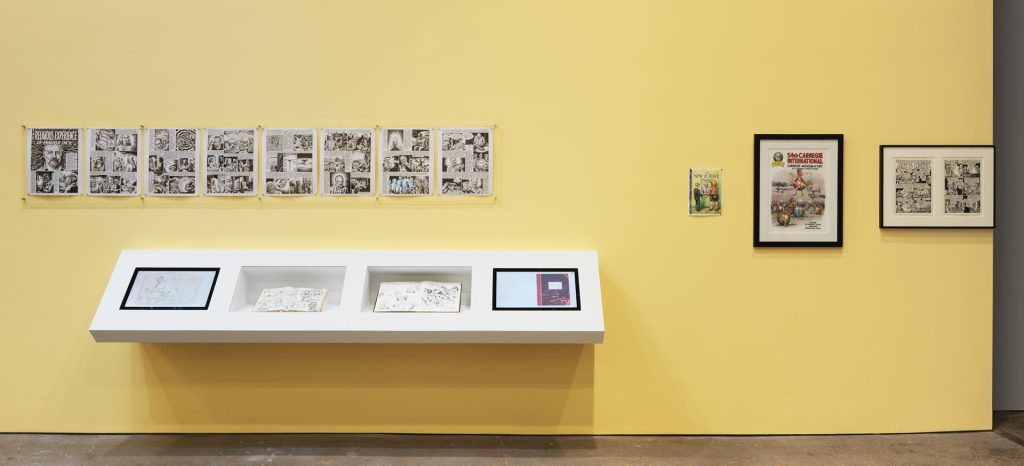
I’m still going through the boxes in this blog’s attic and came across the below review of a 2019 R. Crumb exhibition at the David Zwirner Gallery, which was first published here on March 19, 2019. The exhibition catalog for the show was belatedly published two years later by David Zwirner Books under the title Crumb’s World.
For my birthday, Marilyn and I dropped in at Drawing for Print: Mind Fucks, Kultur Klashes, Pulp Fiction & Pulp Fact by the Illustrious R. Crumb, an exhibition at the David Zwirner Gallery that runs through April 13. The retrospective show, covering Crumb’s career from his earliest talking-animal cartoons through his LSD-soaked fantasies of the 1960s and 1970s to his more recent musings about art, life, and eroticism, is an excellent chance to enjoy an overview of the 75-year-old artist’s work — and, given its controversial nature, such an exhibition would be unlikely to find a home at the larger warehouses of contemporary work like the Museum of Modern Art.
Fortunately, the Zwirner Gallery and exhibition curator Robert Storr have no compunction about showing off Crumb’s shameless explorations of his culture’s and his own perversions. An opening room sets Crumb’s career in the context of the work of other graphic arts satirists, particularly James Gillray, William Hogarth, Thomas Nast, and Art Young. Their political interests do carry through to Crumb’s own work, but Crumb also plumbs his own worst impulses as well as those of his culture. Not a little of his art is in questionable taste, but then, taste is a social construct, and that taste inevitably reflects the deviancies of that society as well. Crumb is, after all, a satirist in the Swiftian mode more than anything else, and his devastating observations about the sexism and racism of his culture resemble the savagery of “A Modest Proposal” and Swift’s more scatalogical parodies and satires. That Crumb implicates himself in his satire as well is another similarity with his Augustan co-conspirator against the human race.
The primary joy of the exhibition is the exquisite craftsmanship of Crumb’s art (Crumb may have the greatest visual acuity of any cartoonist at work today, recalling the traditions of Walt Kelly and George Herriman) — exhibition specimens of his recent work, primarily the Art & Beauty series of publications, demonstrate that he may now be at the top of his form, the detail and texture of his cross-hatching technique most evident with close examination of these original drawings, an examination endlessly revealing.
Crumb is a satirist in the American vernacular tradition, perhaps among the last of them, joining Twain, Mencken, and Gaddis in his mastery of popular form and language. Like them, Crumb can brilliantly parody the varicolored lingo and patois of his nation; like them, too, he revitalizes and reinvents his chosen forms — the comic book, the popular novel, the newspaper column — and twists them to attack his own particular targets. (Crumb, along with being a great graphical artist, is also a great writer, with a rich feel for words and the verbal rhythms of a wide variety of Americans; as Twain once pointed out, “The difference between the almost right word and the right word is really a large matter — it’s the difference between the lightning bug and the lightning,” and Crumb nearly always has access to the right word and the well-placed pause and ellipsis.)
Most of the Zwirner exhibition is composed of comic book ephemera, tearsheets, and sketchbook pages, and it only scratches the surface of Crumb’s career, leaning heavily towards his work of the 1970s and 1980s. Previous exhibitions here and elsewhere have thrown a spotlight on his work with his wife Aline Kominsky-Crumb, and a few samples of collaboration are on view, but they’re not the center of the exhibition’s project; nor is Crumb’s comic-book rendering of Genesis. Among the most interesting samples of his later work are the Art & Beauty drawings and, most recently, Crumb’s two-page evocation of a recent conversation he had with curator Robert Storr. Both reflect Crumb’s ongoing discomfort with his status in the culture as an icon of underground comics and, also, as a fine “artist,” a more contemplative version of the self-mockery with which he regards himself in the earlier stories for his fine Weirdo project of the 1980s.
Drawing for Print offers a portrait of a diseased mind in a diseased culture, which Crumb dissects with the acuity of an Otto Dix or George Grosz. These days, Crumb has entered a more meditative part of his life, and exhibitions like that at the Zwirner seem to be something of a last chance to consider his accomplishment. As Crumb himself told ArtNews in a recent interview to accompany the opening of the exhibition:
In my youth, I was constantly drawing. Drawing was the only thing I could do with competence. I was afraid of people. I hid behind my sketchbook. I don’t draw all the time anymore. Nowadays, I hide behind my ukulele. I guess I’m still afraid of people. I take the ukulele with me everywhere instead of the sketchbook. Fame has made me inhibited and self-conscious about drawing. I stopped enjoying it. Playing those pretty chords of old-time melodies, though, is relaxing and pleasurable.
